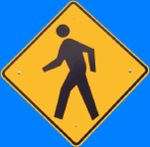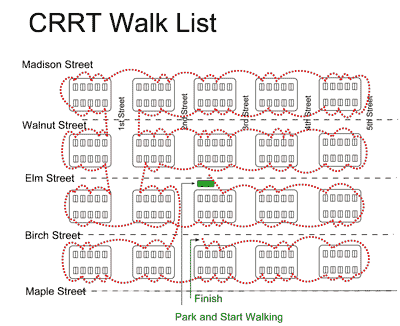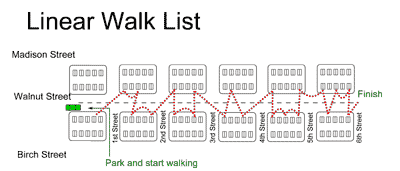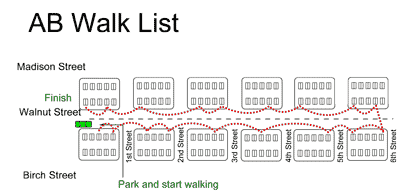Voter Walk Lists
 Campaign Data produces five types of walk lists based on record sortation and reporting criteria: the CRRT Walk List, Linear Walk List, the AB Walk List, the Min Voter Walk List, and a Unique Household Walk List. Additionally, we can provide Walk Cards for those campaign managers who view walk cards as "the better way." The general sortation structure for the various products can be found in the list descriptions below.
Campaign Data produces five types of walk lists based on record sortation and reporting criteria: the CRRT Walk List, Linear Walk List, the AB Walk List, the Min Voter Walk List, and a Unique Household Walk List. Additionally, we can provide Walk Cards for those campaign managers who view walk cards as "the better way." The general sortation structure for the various products can be found in the list descriptions below.
Voters to Target
Campaigns today generally target only quality voters (frequent voters) for walking. Additionally, many campaigns will request walk lists for absentee ballot voters or voters with identifiable minority attributes such as "Hispanic women over 60."
Voter Density Considerations
One of the important considerations in choosing a walk list is the voter density; i.e., the number of people that are in a given geographic area. High density urban areas such as the suburbs of most cities, lend themselves to the CRRT walk list. Rural areas may be better handled by the Linear walk list. The following is a table of page counts based on 4,000 voters from a randomly selected urban area:
| Walk List | Page Count |
|---|---|
| Crrt | 761 |
| Linear | 437 |
| AB | 569 |
| Min | 278 |
| Unique | 37 |
Our Recommendation
Most candidates should select the CRRT Walk List over the Linear Walk List or the Walk Cards. Read about the differences below and you make the decision.
Call us if you have any questions regarding your walk list needs. Our advice and consultation is free, and we may be able to to assist you choosing the best walk list for your district's geography. We are generally available 24/7 for political campaigns, so for the cost of a phone call, you can get the best technical campaign advise in Florida.
Contact Us
CRRT Walk List
CRRT or "Carrier Route" sortation provides a walk list based on the geography of a US Postal Carrier route. Although there is a learning curve to walking this pattern, most political veterans have found it easier and more efficient than using a traditional Linear walk pattern. There are two advantages to walking the CRRT pattern:
- It presents a small, concise, more easily "walkable" grouping of voters than does a precinct based, linear walk list. These are the postal carrier routes (CRRT)
- Most geographical impediments to walking; i.e., canals, dead ends, major highways are factored in, and usually eliminated in a postal carrier's walk pattern.
If, after trying the CRRT version, you are not happy with it, we will furnish the Linear version in PDF format at no additional cost.
In the jargon of data programming, page breaks occur after each precinct change, each carrier route change, each street name change and after exhausting either the even number houses on a street or the odd number houses on the same street.
A more detailed analysis of the CRRT Walk List methodology is furnished further down this page
Linear Walk List
The Linear approach is most often the sortation provided by other voter data providers as well as county Supervisors of Elections. It is based on an alphabetical sort of all street names within a specified precinct and can be easy to follow on paper but can be somewhat more difficult to physically and efficiently negotiate in order to return to your vehicle after your walk.
Only a hand full of campaign managers or candidates have indicated a preference for the Linear Walk List, but it is provided for those candidates who either have a strong preference toward the historically more common walk sortation, or those who feel that a linear approach would be more appropriate to the geography of the district they are walking, as for example, more rural areas. For assistance, contact us.
Page breaks occur at the end of each precinct and street name.
AB (Absentee Ballot) Walk List
Contacting absentee ballot voters (ABs) both through face-to-face contact and by telephone is a critical function of every modern campaign in Florida, but creating a walk list for absentee ballot voters presents a special kind of problem, particularly for single family neighborhoods. AB voters generally represent very few households even in densely populated urban neighborhoods. The AB Walk List is designed around a scarcity of voters rather than an abundance of voters in any particular area. In other words, they are usually not within walking distance of each other in single family neighborhoods; hence, house-to-house contact of AB voters usually requires a driver to ferry you between AB residences.
Working apartment buildings and condominiums on foot is an easier task.
The sortation of an AB walk list tries to keep you on one side of the street in a precinct so that your driver does not have to bounce back and forth on opposite sides of the street to deliver you to homes with AB voters.
Page breaks occur after each precinct.
!!! You may note that the Sample Crrt Walk List and the Sample AB Walk List are identical. This is a consequence of the original universe being the same along with the fact that we confined our universe to one CRRT and one precinct. The idea is the same, however.
Walk list Field and Code Explanations
Min Voter Walk List
This walk list is designed around the situation where there are very few voters per precinct that match the criteria you used for selecting the target voters to walk. The most common scenario is when there are only a page or two of voters in a precinct. The only page changes occur when precincts change. All of the address in a precinct are simply sorted alphabetically and numerically as one long list.
Unique Household Walk List
Occasionally, you may need to do nothing more than hand out fliers at homes where there are voters, and the quantity may be too small for a mailer. You do not need to know the names of the voters at the residences. You want merely to deliver your literature. This is an activity that can be done during the day when most people are at work.
An example would be when the Department of Elections changes or consolidates a a particular precinct polling site just prior to an election. You can deliver a personal message to a voting household in the precinct that the address of the polling facility has been changed
We produce a list of voter residences for this activity. Not used very often, but it is better than carrying around a whole stack of individual voter walk lists.
Walk Cards
Walk cards can be both a blessing and a nightmare. The theory is sound: after walking numerous houses, the cards representing an entire household of voters can be sorted into piles of supporters vs non-supporters, or whatever other criteria you are interested in.
The sortation is designed around the candidate being driven from one house to the next. The actual house-to-house walk sequence is identical to the Linear Walk List by popular demand. The sortation is a little different in that I place the voters on the card by quality in descending order; therefore, the best voters are at the top.
Pros:
- Cards can be segregated by whatever criteria is important, and there is a strong advantage, administratively, to using cards.
- There is more room to write comments on the cards than on walk lists.
Cons:
- They can be very difficult to walk because there is no reference point indicating where you are in relation to other voters in the vicinity.
- Dropping or mixing up the cards while walking can make things difficult. I include sequential numbering on the cards, but it is still a problem not encountered when using traditional walk lists as opposed to walk cards.
- The actual programming of the cards is complicated and limits the number of voters we can print out from any household to five (5), even if there are 8 voters in the household. Rarely is this encountered, but it is a consideration.
- The cards are more expensive to produce.
The candidate is usually responsible for printing and cutting the cards, although we can do it if the candidate is willing to pay for postage and handling. The PDF file we produce prints the cards three-up on 8 1/2 by 11 inch card stock and a high speed laser printer is generally required. You will also need a print shop or office supply store near by with the equipment necessary for cutting the cards from the 8 1/2 by 11 inch stock. Kinkos and Office Depot are two national companies usually capable of cutting the card stock in-house.
CRRT Methodology
In 1994, Lynea and I were civic activists in our community. We created a newsletter and over a period of a few months, personally delivered over 15,000 newsletters to city residents. Our first walk list was generated by the County Supervisor of Elections. It appeared to be sorted rather oddly and proved to be inefficient to use. Being a mathematician and somewhat familiar with computers, I began trying to design a walk list that worked. After two months of walking, redesigning the data sorts and page information, and consulting with mail houses, we arrived at what has become a standard walk list for over 465 Florida campaigns.
U S Postal Carrier Routes
Perhaps the most important conclusion we reached in our search for an efficient walk list was that we needed to park our car where ever we wanted, and after walking for an hour or so, wind up in close proximity to where we had parked. The least efficient method of walking was to follow a list that gave us one street at a time that went on for many blocks or even miles (Linear Walk List). Although we could design a linear walk list to walk the even house numbers on one side of the street first and then walk back on the other side of the street using the odd number addresses, this did not take into account the frequently encountered empty lots on one side or the other nor any geographical impediments such as a dead end, a canal, or a major roadway. Also, whenever we got tired of talking to people, we would often have to walk a long way back to our car.
The goal was to design a walk list that kept us within a short distance of our car and yet stretched to enough residences so that our time was used as efficiently as possible. The answer was to address standardize all the voters addresses using US Postal software and then sort the walk list based on, first, precinct geography and, second, on US Postal carrier route information.
Precincts Contain Carrier Routes (CRRT)
While some rural areas of Florida may have precincts that coincide one-to-one with the geography of Postal carrier routes, most do not. Below is a typical representation of how carrier routes are a subset of a precinct.

The next illustration below is what a typical walk list page looks like and where the precinct, zip code and all important carrier route (CRRT) information is located.

Summary of Walk Patterns
In summary, here are rather rough visual representations of the three types of walking patterns the lists are designed to generate. What is displayed is the easily obtainable, optimal pattern for which the sortation and lists were designed.

The various walk sheets within an individual carrier route can be sorted to allow moving in a somewhat circular motion around the location of your vehicle.

Envision this street being 20 blocks long. The subsequent 10 pages of your walk list will provide only addresses along this street. The plus for this list is that it can be a more intuitive pattern than a CRRT Walk List.

As with the Linear Walk List, envision this street being 20 blocks long. This list is, however very conducive to driving where voters live many houses away from each other as Absentee Ballot voters may be. This is easier to drive than the Linear Walk List.
Contact Us | Terms of Use | Privacy Policy | Site Map
Copyright © 2009 Campaign Data, Inc All Rights Reserved